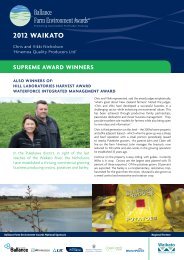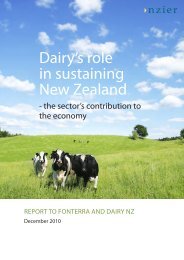Living and working on a New Zealand dairy farm - Settlement Support
Living and working on a New Zealand dairy farm - Settlement Support
Living and working on a New Zealand dairy farm - Settlement Support
Create successful ePaper yourself
Turn your PDF publications into a flip-book with our unique Google optimized e-Paper software.
A year <strong>on</strong> a <strong>dairy</strong> <strong>farm</strong><br />
Weather Looking after yourself Work<br />
WiNter · June – August<br />
Usually the wettest seas<strong>on</strong>. It<br />
can also be very cold with frost,<br />
snow <str<strong>on</strong>g>and</str<strong>on</strong>g> ice. Temperatures<br />
normally range from 5-15 °C<br />
(41-59 °F) during the day. Cold<br />
winds can make it feel much<br />
colder. In the middle of winter<br />
there are <strong>on</strong>ly 9 – 10 hours of<br />
sunlight a day.<br />
SpriNg · September – November<br />
The temperatures start getting<br />
warmer <str<strong>on</strong>g>and</str<strong>on</strong>g> the grass starts to<br />
grow fast. There is still plenty<br />
of rain.<br />
Summer · December - February<br />
It gets warmer - from 20-30 °C<br />
(68-86 °F) in the day. It normally<br />
rains less. The sun can be very<br />
str<strong>on</strong>g <str<strong>on</strong>g>and</str<strong>on</strong>g> can make your skin<br />
burn within l0 minutes. The sun is<br />
hottest between 11am <str<strong>on</strong>g>and</str<strong>on</strong>g> 4pm.<br />
In mid summer there is 15 - 16<br />
hours of sunlight in the day.<br />
AutumN · March – May<br />
Temperatures start to get<br />
cooler <str<strong>on</strong>g>and</str<strong>on</strong>g> there is plenty of<br />
rain.<br />
7 | A guide for migrant <strong>dairy</strong> <strong>farm</strong> workers<br />
Wear layers of clothing.<br />
Wear clothes made out<br />
of materials such as<br />
wool, polypropylene, <str<strong>on</strong>g>and</str<strong>on</strong>g><br />
waterproof clothing. D<strong>on</strong>’t<br />
wear cott<strong>on</strong> - <strong>on</strong>ce it is wet<br />
it stays wet for a l<strong>on</strong>g time,<br />
making you cold. Wearing a<br />
wool hat helps to c<strong>on</strong>serve<br />
body heat. Eat warm meals to<br />
give you the energy you need.<br />
Although the mornings can<br />
still be cold, the days can<br />
get quite warm. It is best<br />
to wear layers of clothing<br />
that can be removed as it<br />
warms up.<br />
The <strong>New</strong> Zeal<str<strong>on</strong>g>and</str<strong>on</strong>g> sun can<br />
burn your skin in 10 minutes<br />
so it is very important<br />
to wear sunscreen <str<strong>on</strong>g>and</str<strong>on</strong>g><br />
lipbalm (SPF 30+) <str<strong>on</strong>g>and</str<strong>on</strong>g> wear<br />
sunglasses <str<strong>on</strong>g>and</str<strong>on</strong>g> a sun hat.<br />
Try to wear light clothing<br />
that covers your skin.<br />
Although the mornings can<br />
still be cold, the days can<br />
get quite warm. It is best to<br />
wear layers of clothing.<br />
July – September is<br />
calving time. It’s a busy<br />
time <str<strong>on</strong>g>and</str<strong>on</strong>g> because it gets<br />
cold, looking after the<br />
cows <str<strong>on</strong>g>and</str<strong>on</strong>g> their calves is<br />
very important.<br />
October – December is<br />
the time when the cows<br />
are giving the most milk.<br />
It is also the time when<br />
mating <str<strong>on</strong>g>and</str<strong>on</strong>g> artificial<br />
breeding (AB) starts, the<br />
grass is turned into hay<br />
or silage, <str<strong>on</strong>g>and</str<strong>on</strong>g> turnips are<br />
planted for the cows to<br />
eat later in the seas<strong>on</strong>.<br />
In summer the milking<br />
c<strong>on</strong>tinues, as do<br />
activities such as making<br />
hay, caring for the<br />
animals, <str<strong>on</strong>g>and</str<strong>on</strong>g> planting<br />
crops.<br />
April – May is when milking<br />
stops (dry-off). A time<br />
for repairs to fencing,<br />
drainage, irrigati<strong>on</strong><br />
systems, <str<strong>on</strong>g>and</str<strong>on</strong>g> equipment.<br />
Trees may be planted.

















